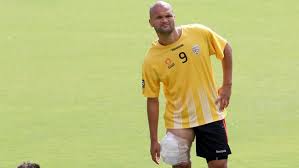Quadriceps Contusion
This is the result of sustaining a direct blow to the front of the thigh, resulting in tissue damage and a subsequent hematoma (or bleed). It is more commonly referred to as a ‘Corked Thigh’. Trauma causes damage to the muscle cells, fascia and blood vessels. It is important that it is managed well as this injury can sometimes progress to “myositis ossificans” or post-traumatic ossification (a painful condition in which bone grows in the muscle belly).
This is the result of sustaining a direct blow to the front of the thigh, resulting in tissue damage and a subsequent hematoma (or bleed). It is more commonly referred to as a ‘Corked Thigh’. Trauma causes damage to the muscle cells, fascia and blood vessels. It is important that it is managed well as this injury can sometimes progress to “myositis ossificans” or post-traumatic ossification (a painful condition in which bone grows in the muscle belly).
Clinical Features
Depending on the degree of damage pain can range from mild symptoms which don’t restrict activity to severe, making walking on the leg impossible. There is often swelling through the thigh and sometimes bruising.
Diagnosis
The diagnosis is usually made through history and clinical assessment. Investigations such as x-ray are only required to assess for other injury e.g. fracture or myositis ossificans.
Treatment
Non-operative conservative management would usually involve the following:
Stage 1
- ACUTE INFLAMMATORY NECROTIC PHASE Day 0-3
- Immobilisation, ice and rest helps control initial bleeding and inflammatory response, protects from further mechanical insult.
- 1 session is required for acute care. A second followup session if imaging is required or DVT risk.
- Management – Complete rest, non weigtbearing if possible, boot?, Strapping, ice, compression, immobilise muscle in painfree lengthened position if possible. Adust painfree lengthened position day 2.
Stage 2
- LATE PART OF INFLAMMATORY PHASE BEGINNING OF PROLIFERATIVE PHASE Day 4
- Early mobilisation promotes more capilliary ingrowth as well as better muscle fibre orientation
- 2 – 3 supervised sessions are required to teach exercises, ensure that volume is appropriate and technique is correct. Some support tape may be required.
- Management – Teach pain free stretch, exercises to maintain fitness, including upper body and core strength program, massage to uninvolved part of muscle, strapping , unassisted ambulation if pain free, stretching to uninjured muscle.
Stage 3 (2-3 sessions)
- REGENERATIVE/REPAIR/PROLIFERATIVE PHASE Approximately day 7-10
- No pain with moderate stretch and normal walking
- Early mobilisation promotes more capillary ingrowth as well as better muscle fibre orientation.
- Visits 2-3 are required for exercise prescription to ensure volume is appropriate and to ensure technique is correct, massage to affected muscle.
- Basic concentric and eccentric strengthening for involved muscle including use of pilates bed, general strengthening and more advanced cardiovascular conditioning, stretching to uninjured muscles.
Stage 4 (4 sessions)
- CONTINUATION OF THE REGENERATIVE PHASE AND START OF THE REMODELLING PHASE Approximately day 14 – 21
- Progression of weight training to functional and activity specific activities including co-ordination drills and plyometrics.
- 3 visits are required for exercise prescription to ensure volume is appropriate and to ensure technique is correct, massage to affected muscle.
Stage 5 (4 sessions)
- FITNESS TEST Approximately day 21 – 35
- 1 visit is required for fitness test – check range, concentric/eccentric strength, functional
- strength, sports specific activity.

